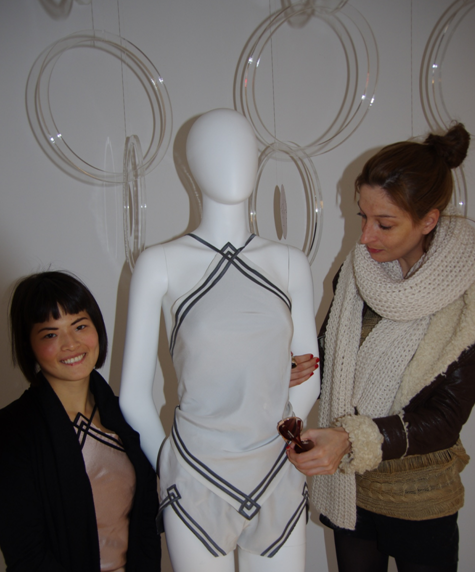It's oh so quiet… Irene Lu
- By Elsbeth van Paridon
 0 Comment(s)
0 Comment(s) Print
Print E-mail China.org.cn, October 31, 2013
E-mail China.org.cn, October 31, 2013
"Sshht sshhht…" Aside from a Björk song – who herself has been shrouded in clouds of silence over the past years, though that may just be my perception – it's also the name of Irene Lu's latest collection for her brand LYL Pillowbook. Collection of what you may ask? (Love Your) Lingerie: the most intimate, risqué, seductive and even secretive of all that design entails.
I suppose this piece is more of a celebration of China's history of seduction and the world's female curves (I am not a feminist by any means, but I do like my underwear), but even so it's a celebration begeistert by Lu's newly established brand. From Taoism to teahouses, from robes to ropes; they're all linked together by the dangling gold chains in Lu's concoctions.
|
Irene Lu (L) in one of her own creations, also featuring the curvaceous outline of Beijing's traditional hutongs. |
Dangerous liaisons
The liaison between lingerie and liberation, that is. The history of women's lingerie and women's (literal) liberation is as entwined as the ancient story of the pillow-book and Lu's brand. From stiff whalebone-supported corsets turning the upper body into an inverted cone and whipping the waistline in all possible shapes and positions known to man, to separate bras and panties in the 1920s that literally liberated the woman's torso from nearly four centuries of entanglement and bodily "suppression;" the affair between women and their undergarments has been an intense one, not one of all-devouring great love, but surely one to remember.
Our modern day lives witness the occasional rendezvous with times long gone. This is no different with the Pillowbook brand; the name alone raises a slinky question mark. Back in the day when the robes of Confucius were yet to be sown, "China," or the various Chinese states and kingdoms to dot the historical I's, mainly considered Taoism as the Marlies Dekkers of religions. In a day and age where girls would often marry around the age of 12, they were given a so-called pillow-book on their big day; a pint-sized booklet to be kept next to your pillow that served as a guide to lovemaking. Seduction is indeed an art.
The miniature teasers contained masterfully painted erotic scenarios depicting a new bride and her man. Unfortunately, many of these tiny-Botticelli-toned artifacts were destroyed during the early days of Communist China (1949) as they were deemed inappropriate. The clothing at this particularly riotous time was of course unisex; no clicking of glamour heels, slashing of 1930s Shanghai red lipstick or squeeze of perfume flaunted the streets. Especially in a world that aimed for gender equality, lace and garter belts had no place. Too scandalous.
|
The dudou. With a vengeance. |








Go to Forum >>0 Comment(s)